Abstract
Caesarean-derived, colostrum-deprived swine were exposed to a broth culture of a low passage field isolate of Mycoplasma hyopneumoniae by intranasal inoculation. The intranasal-inoculated swine subsequently were commingled with their litter-mates to effect transmission via contact-exposure. Sera were collected from the swine at two to four week intervals for approximately one year postexposure and evaluated by the enzyme-linked immunosorbent assay (ELISA), indirect hemagglutination and complement fixation tests. The intranasal-exposed swine seroconverted earlier, developed higher titers and remained indirect hemagglutination and complement fixation positive longer than the contact-exposed swine. It was concluded that the antibody response of intranasal-exposed swine was artificially high and that sera from such swine were not suitable for evaluating the sensitivity of mycoplasmal pneumonia of swine serodiagnostic tests. The indirect hemagglutination test was relatively insensitive and technically cumbersome and the least promising as a practical field test. The complement fixation test appeared to be slightly more sensitive in detecting early antibody production (especially in contact-exposed swine) but it was the least sensitive in detecting late antibodies. The ELISA was generally the most sensitive procedure. Individual high ELISA titers were from ten to 32 times greater than maximum complement fixation and indirect hemagglutination titers. The most striking difference among the three tests was the persistence of high ELISA titers late in the study. All swine were ELISA positive at necropsy approximately one year postexposure despite the fact that lungs were devoid of lesions and culturally and immunofluorescent negative for M. hyopneumoniae.
Full text
PDF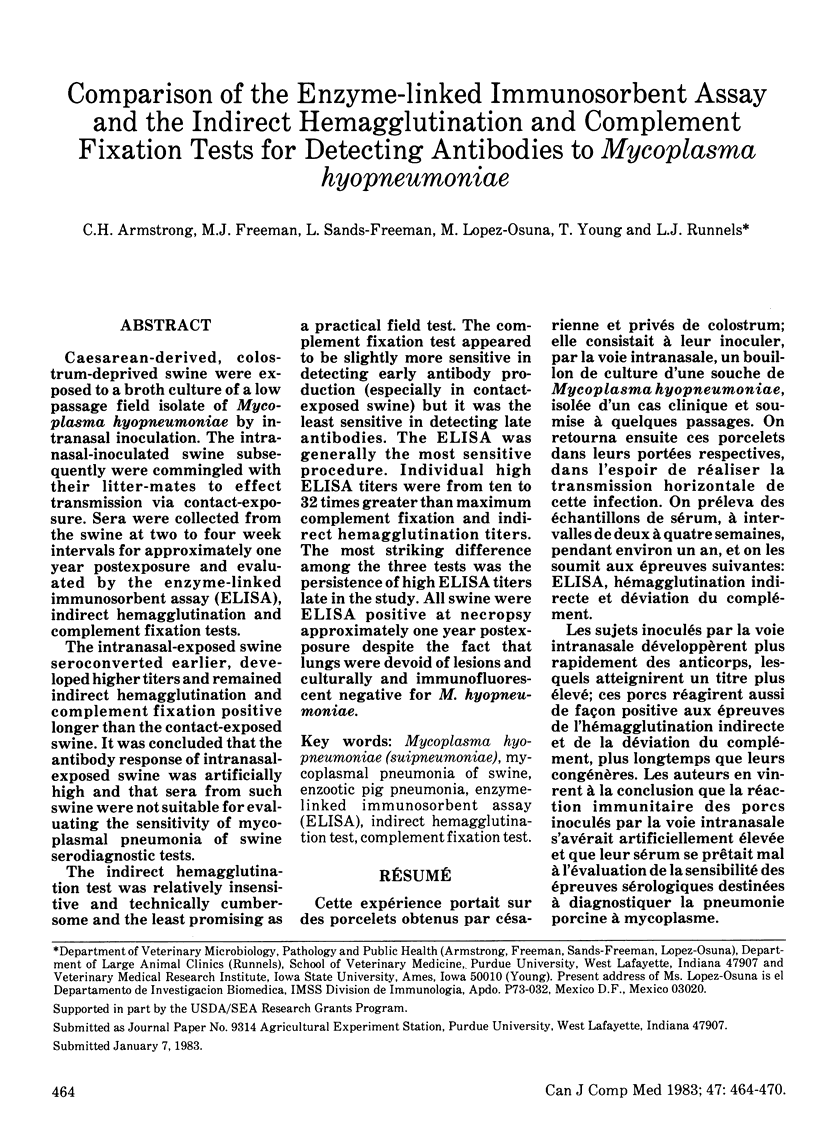
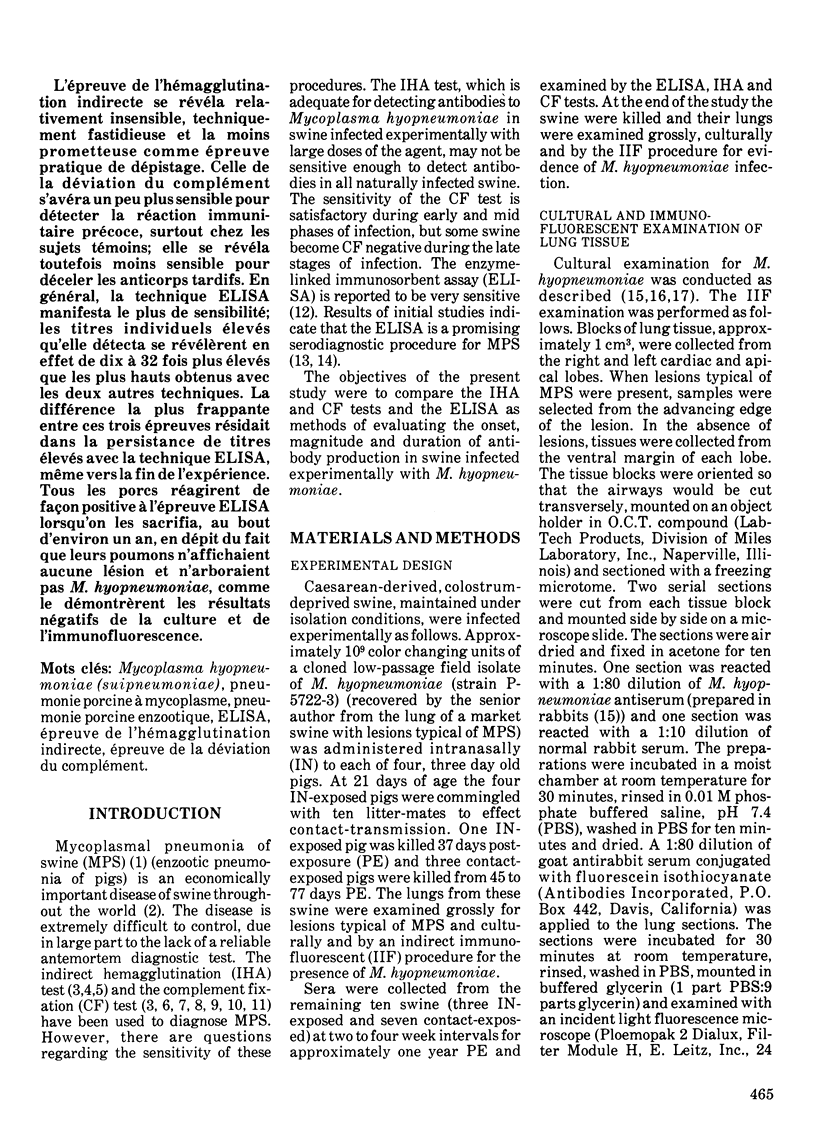

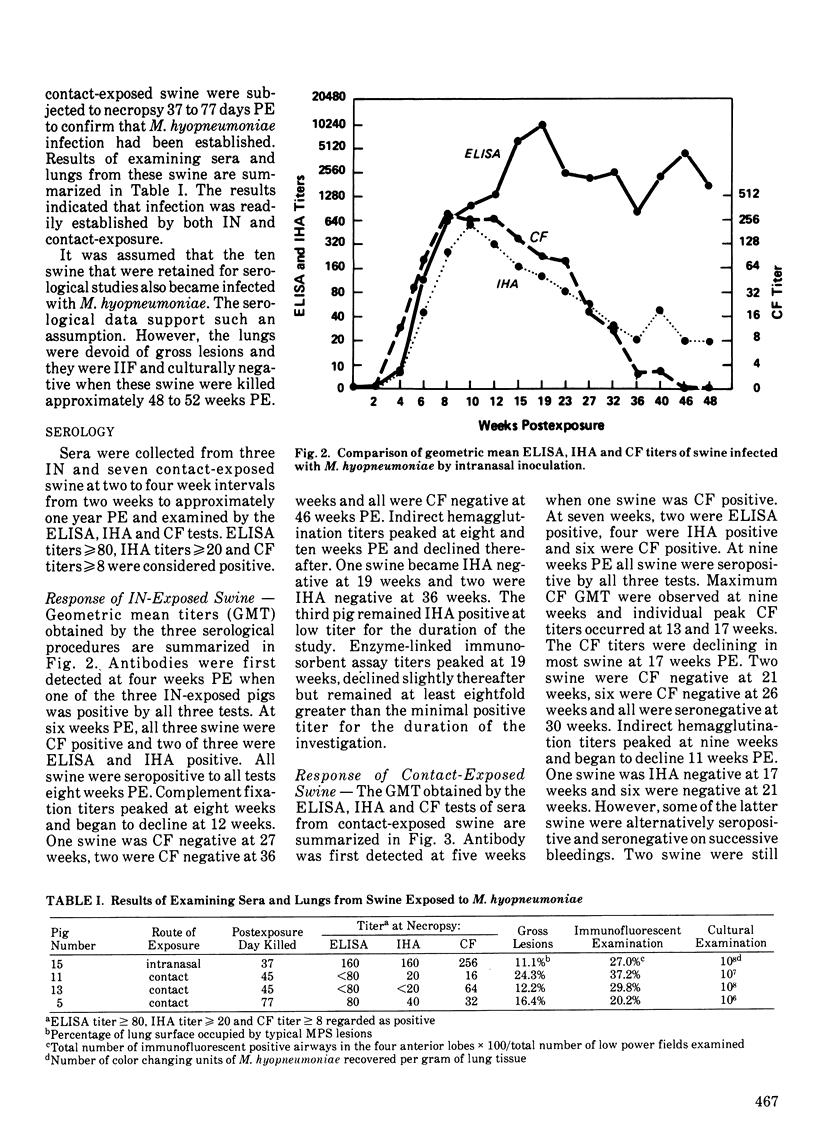
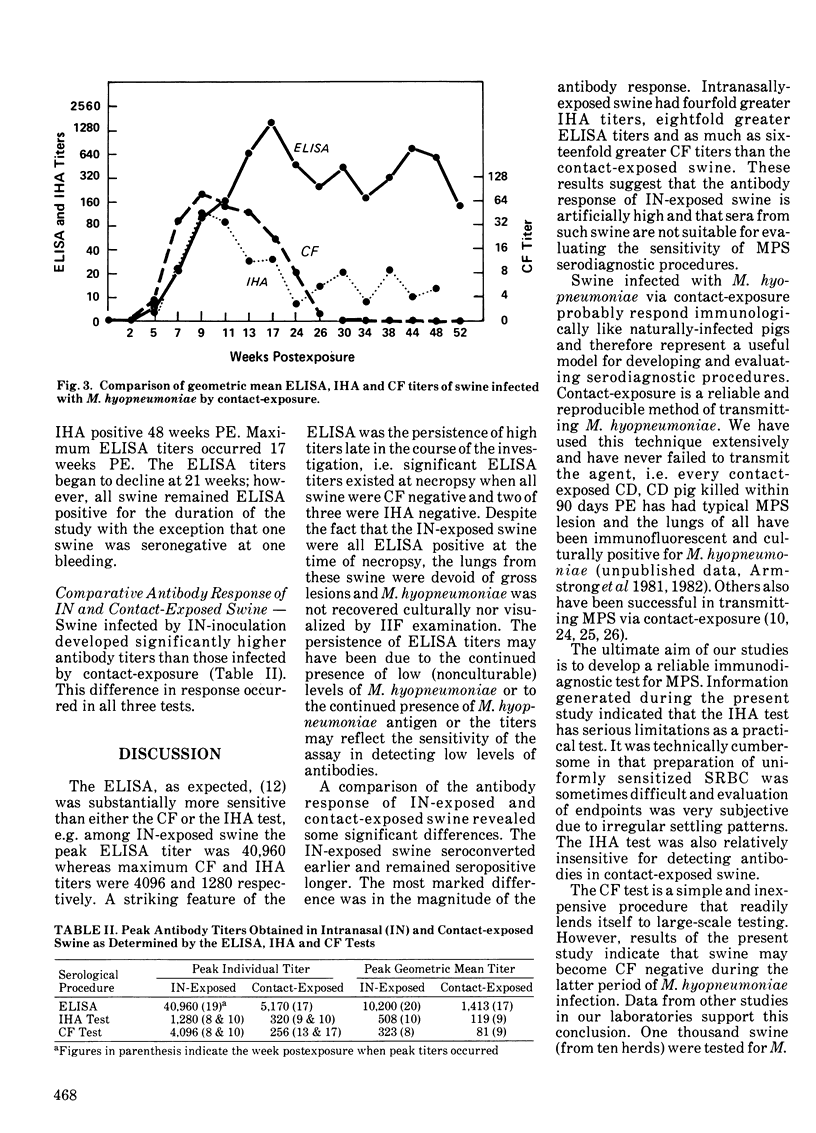
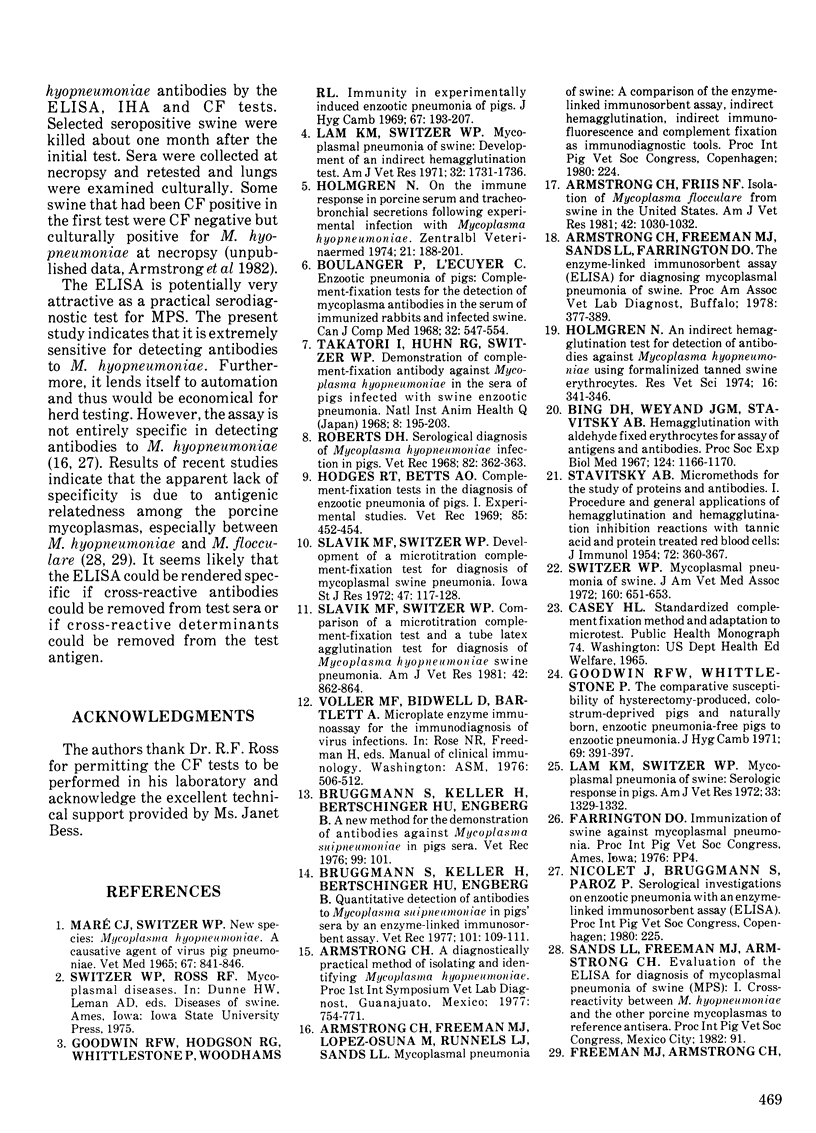
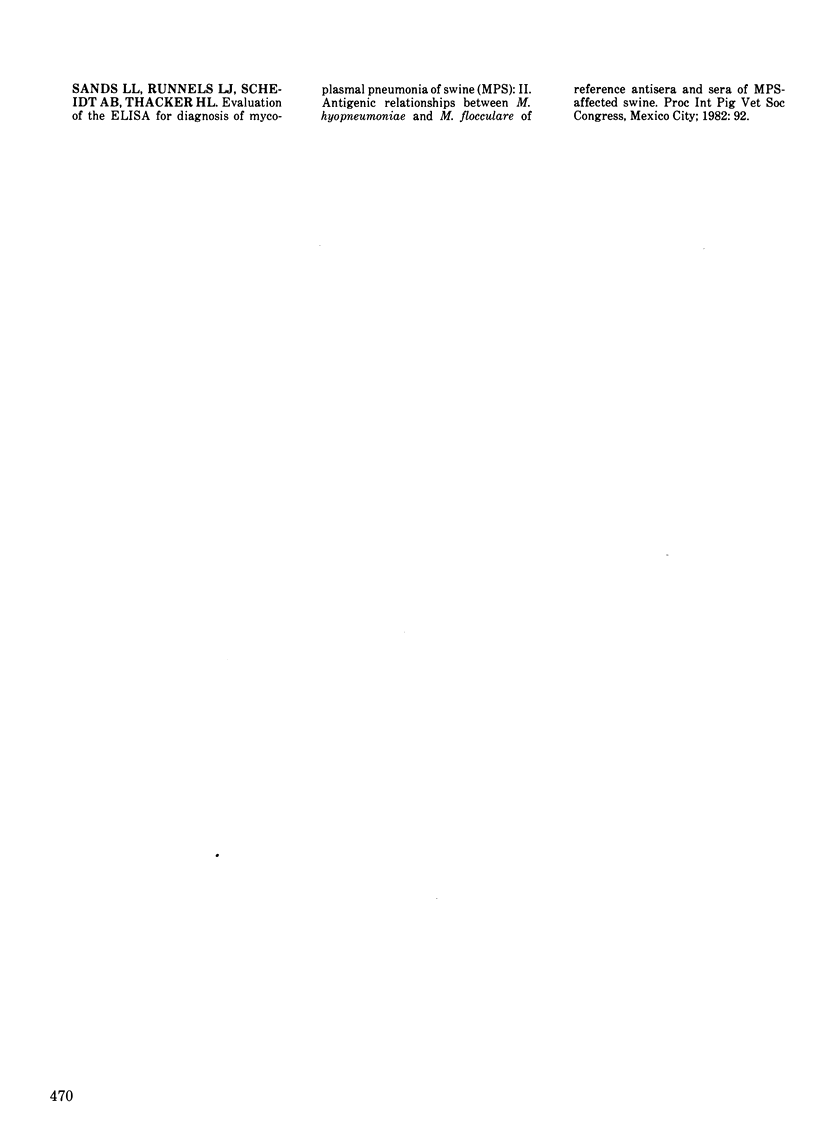
Images in this article
Selected References
These references are in PubMed. This may not be the complete list of references from this article.
- Armstrong C. H., Friis N. F. Isolation of Mycoplasma flocculare from swine in the United States. Am J Vet Res. 1981 Jun;42(6):1030–1032. [PubMed] [Google Scholar]
- Bing D. H., Weyand J. G., Stavitsky A. B. Hemagglutination with aldehyde-fixed erythrocytes for assay of antigens and antibodies. Proc Soc Exp Biol Med. 1967 Apr;124(4):1166–1170. doi: 10.3181/00379727-124-31953. [DOI] [PubMed] [Google Scholar]
- Boulanger P., L'Ecuyer C. Enzootic pneumonia of pigs: complement-fixation tests for the detection of mycoplasma antibodies in the serum of immunized rabbits and infected swine. Can J Comp Med. 1968 Oct;32(4):547–554. [PMC free article] [PubMed] [Google Scholar]
- Bruggmann S. T., Keller H., Bertschinger H. U., Engberg B. A new method for the demonstration of antibodies against Mycoplasma suipneumoniae in pigs sera. Vet Rec. 1976 Aug 7;99(6):101–101. doi: 10.1136/vr.99.6.101. [DOI] [PubMed] [Google Scholar]
- Bruggmann S., Keller H., Bertschinger H. U., Engberg B. Quantitative detection of antibodies to Mycoplasma suipneumoniae in pigs' sera by an ezyme-linked immunosorbent assay. Vet Rec. 1977 Aug 6;101(6):109–111. doi: 10.1136/vr.101.6.109. [DOI] [PubMed] [Google Scholar]
- Goodwin R. F., Hodgson R. G., Whittlestone P., Woodhams R. L. Immunity in experimentally induced enzootic pneumonia in pigs. J Hyg (Lond) 1969 Jun;67(2):193–208. doi: 10.1017/s0022172400041607. [DOI] [PMC free article] [PubMed] [Google Scholar]
- Goodwin R. F., Whittlestone P. The comparative susceptibility of hysterectomy-produced, colostrum-deprived pigs and naturally born, enzootic-pneumonia-free pigs to enzootic pneumonia. J Hyg (Lond) 1971 Sep;69(3):391–398. doi: 10.1017/s002217240002163x. [DOI] [PMC free article] [PubMed] [Google Scholar]
- Hodges R. T., Betts A. O. Complement-fixation tests in the diagnosis of enzootic pneumonia of pigs. I. Experimental studies. Vet Rec. 1969 Oct 25;84(17):452–455. doi: 10.1136/vr.84.17.452. [DOI] [PubMed] [Google Scholar]
- Holmgren N. An indirect haemagglutination test for detection of antibodies against Mycoplasma hyopneumoniae using formalinized tanned swine erythrocytes. Res Vet Sci. 1974 May;16(3):341–346. [PubMed] [Google Scholar]
- Holmgren N. On the immune response in porcine serum and tracheobronchial secretions following experimental infection with Mycoplasma hypopneumoniae. Zentralbl Veterinarmed B. 1974 Mar;21(3):188–201. doi: 10.1111/j.1439-0450.1974.tb00491.x. [DOI] [PubMed] [Google Scholar]
- Lam K. M., Switzer W. P. Mycoplasmal pneumonia of swine: development of an indirect hemagglutination test. Am J Vet Res. 1971 Nov;32(11):1731–1736. [PubMed] [Google Scholar]
- Lam K. M., Switzer W. P. Mycoplasmal pneumonia of swine: serologic response in pigs. Am J Vet Res. 1972 Jul;33(7):1329–1332. [PubMed] [Google Scholar]
- MARE C. J., SWITZER W. P. NEW SPECIES: MYCOPLASMA HYOPNEUMONIAE; A CAUSATIVE AGENT OF VIRUS PIG PNEUMONIA. Vet Med Small Anim Clin. 1965 Aug;60:841–846. [PubMed] [Google Scholar]
- STAVITSKY A. B. Micromethods for the study of proteins and antibodies. I. Procedure and general applications of hemagglutination and hemagglutination-inhibition reactions with tannic acid and protein-treated red blood cells. J Immunol. 1954 May;72(5):360–367. [PubMed] [Google Scholar]
- Slavik M. F., Switzer W. P. Comparison of a microtitration complement-fixation test and a tube latex agglutination test for diagnosis of Mycoplasma hyopneumoniae swine pneumonia. Am J Vet Res. 1981 May;42(5):862–864. [PubMed] [Google Scholar]
- Switzer W. P. Mycoplasmal pneumonia of swine. J Am Vet Med Assoc. 1972 Feb 15;160(4):651–653. [PubMed] [Google Scholar]
- Takatori I., Huhn R. G., Switzer W. P. Demonstration of complement-fixation antibody against Mycoplasma hyopneumoniae in the sera of pigs infected with swine enzootic pneumonia. Natl Inst Anim Health Q (Tokyo) 1968 Winter;8(4):195–203. [PubMed] [Google Scholar]



